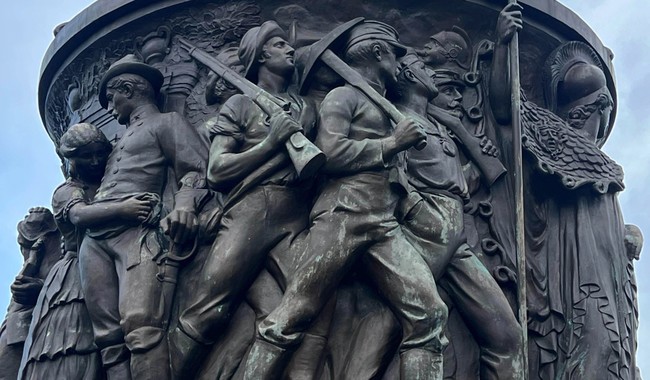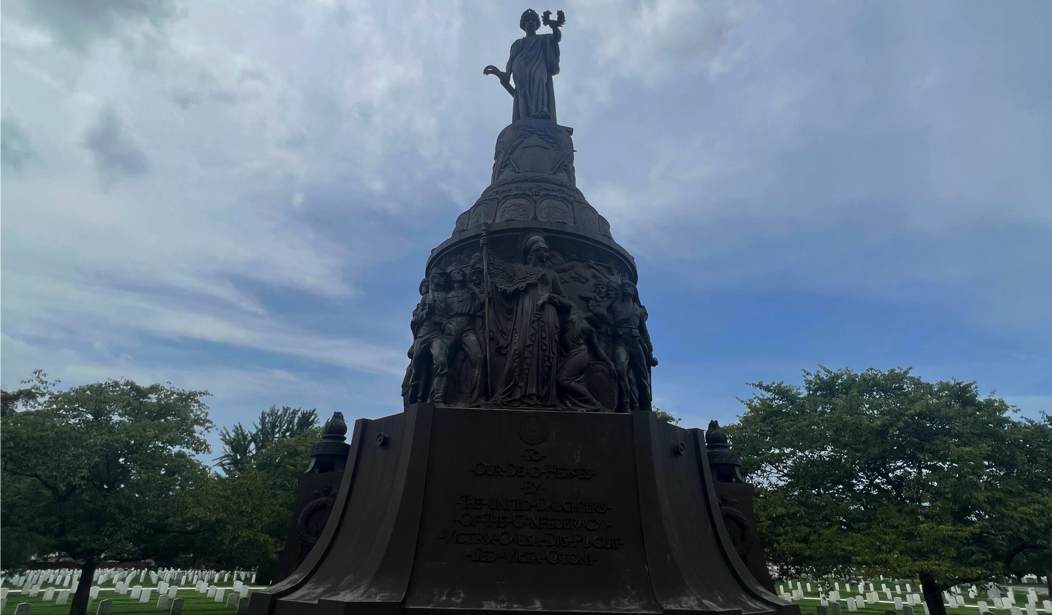The chief of the National Sons of Confederate Veterans heritage operations told RedState he urges his members and supporters to comment at Wednesday’s virtual hearing hosted by Arlington National Cemetery regarding the woke Pentagon-recommended removal of the Confederate Memorial.
“That hearing, it’s part of their environmental impact study, and they're having to give people give their opinion about whether or not is advantageous or disadvantageous to take that monument down,” said James Ronald Kennedy, who with his brother Walter Donald Kennedy, wrote the book “Jefferson Davis: High Road to Emancipation and Constitutional Government.”
“We, the Sons of Confederate Veterans, have a suit that we filed to try to prevent it,” Kennedy said. “That’s sort like the Ukrainians going into the courts of the Soviet Union expecting to get a fair hearing.”
Congress charged the Pentagon's Naming Commission to rid the entire military inventory of roads, buildings, installations, awards, insignia, memorials and any other manifestations of references to the Confederacy and Confederate combatants who served the South voluntarily.
President Donald J. Trump vetoed the fiscal year 2021 Pentagon budget because it included the Naming Commission, but his veto was overridden.
In the commission’s third and final report, the panel recommended that the Army, which runs the cemetery, strip the monument of its bronze, including the 32 figures, the plaques honoring the 14 states who sent soldiers to fight for the Confederacy and the large female figure holding the wreath of olive branches at the top.

There is also a recommendation to destroy the bronze work created by sculptor Moses Ezekiel. All that would remain would be the granite base with educational signage. Congress specifically put grave markers outside the commission’s remit, so while the artwork is removed, the grave marker function of the memorial’s base remains.
Kennedy said the monument serves many purposes.
The first is that it commemorates the more than 400 Confederate soldiers and their wives laid to rest at Section 16, along with all the other Southern soldiers who never returned home, buried in unmarked graves scattered all over the South, he said.
“That’s what every monument represents in every courthouse across the South,” he said.
“It had to do with memorializing veterans--giving family members whose sons, brothers, husbands did not return, buried in unmarked graves all across the south, give them a place to remember their loved ones that did not return,” Kennedy said.
“They sacrificed all for their country, and that's what it was,” he said. “Unfortunately, it's turned into an emotional issue for political purposes.”
Kennedy said President William McKinley first authorized Confederate soldiers to be given rest at Arlington. McKinley was taken by the sacrifices of Southerners in the Spanish-American War.
"It is also the fact that despite this horrible war that we went through and the horrors of reconstruction that we went through as a nation, we came out on the other side as a united people," he said.
“McKinley was so moved because most people don't realize that when the Spanish-American War was being threatened, a lot of people, especially in the North, were concerned, well, would the South even support us?” he said.
He said there were suspicions in the North that Southerners might join with Spain against the U.S. These suspicions were quickly dispelled as Confederate veterans volunteered t to fight for the reconciled country.
“Not only Confederate veterans but also the sons of Confederate veterans served right beside the Union veterans and the sons of Union veterans,” Kennedy said.
In 1906, Secretary of War William Howard Taft, the future president, and Supreme Court chief justice, authorized the United Daughters of the Confederacy to fundraise for the memorial.
When President T. Woodrow Wilson spoke at the monument’s June 4, 1914, dedication; he spoke about the reconciliation the monument represented as only possible in a democracy.
My privilege is this, ladies and gentlemen: To declare this chapter in the history of the United States closed and ended, and I bid you turn with me with your faces to the future, quickened by the memories of the past, but with nothing to do with the contests of the past, knowing, as we have shed our blood upon opposite sides, we now face and admire one another.
Kennedy said one of the signals that a war is over and peace is achieved is when the defeated enemy is allowed to honor their war dead.
“If the victorious side starts to desecrate their enemies war memorials, it means the war is back on,” he said.
“Look at what happens when divers find a sunken Japanese battleship,” he said.
“They will inform the Japanese government, and they would turn that into a memorial, a gravesite--not allowing anybody near it,” he said. “We don't desecrate those memorials, even though they're a thousand feet underwater.”
Kennedy said no one was worse to American soldiers than the Japanese soldiers, but Southerners are no longer given the same respect.
“We are American citizens, Americans, descendants of the founding fathers, our heroes cannot be honored, and we're not allowed to honor their graves.”
The Confederate section is off the tourist trail at the base of the hill on the western edge of the cemetery, near the Old Post Chapel Gate and at the intersection of Farragut Drive and McPherson Drive.
It is also distinctive for the design of the tombstones and the section itself.
Unlike all the other government-provided white grave markers with their rounded top, the Confederate stones are capped with a pointed top.
Similarly, unlike the straight rows and rows of stones that mark the more than 400,000 graves at the cemetery, at the Confederate section, the graves and stones are arranged in a circle to strike a contrast.














Join the conversation as a VIP Member